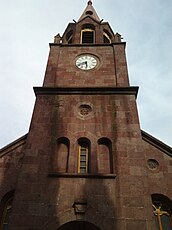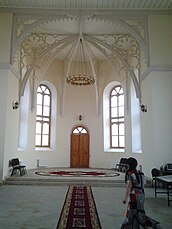Göygöl (city)
| Goygol | ||
|
||
| State : |
|
|
| Rayon : | Goygol | |
| Founded : | 1819 | |
| Coordinates : | 40 ° 35 ′ N , 46 ° 19 ′ E | |
| Height : | 670 m | |
| Residents : | 18,200 (2014) | |
| Time zone : | AZT ( UTC + 4 ) | |
| Telephone code : | (+994) 2220 | |
| Postal code : | AZ2500 | |
| License plate : | 25th | |
| Community type: | City (şəhər) | |
|
|
||
Göygöl is a city in Azerbaijan . It is the capital of the Göygöl district . The city had around 18,200 inhabitants in 2014. The place founded by Swabia , from what was then the Kingdom of Württemberg , as Helenendorf , was called Chanlar from 1938 to 2008 , also Xanlar or in Russian Ханлар .
history
Development of the city name
The original name of the city as "Helenendorf" derives from the Grand Duchess Elena Pawlowna , the second daughter of Paul I of Russia (1754-1801) and his second wife, Tsarina Maria Feodorovna (1759-1828), (before marriage known as Princess Sophie Dorothee von Württemberg ). On November 29, 1938, the place received city rights, with simultaneous renaming in "Xanlar" after the Azerbaijani labor leader Xanlar Səfərəliyev (1885-1907). On April 25, 2008, the Azerbaijani parliament decided to rename the city to “Göygöl” (German for “blue lake”) after a nearby lake.
Founded as a settlement by Caucasian Germans
On May 10, 1817, Tsar Alexander I approved the resettlement of 700 Swabian families to Transcaucasia . The city of Ulm was then designated as a collection point from where the settlers were sent on ships down the Danube to Ismajil , Ukraine. The first settlers from this group were brought to the German Black Sea colonies such as Peterstal, Josefstal, Karlstal and others that already existed in Ukraine in the winter of 1817 .
The founding settlers only arrived in Transcaucasia accompanied by Cossacks in August 1818. Of the original 700 Swabian families who left Ulm, only about 400 reached their destinations; some of the emigrants died of disease on the way to Transcaucasia and others remained in the Black Sea region. At the same time around 100 more families from the Black Sea colonies joined the immigrants to Transcaucasia. From 1817 on, six settlements were founded in Transcaucasia in Georgia and two in Azerbaijan : Annenfeld and Helenendorf.
The place was founded in 1819 by 127 Swabian families (approx. 600 settlers) as Helenendorf. The founding fathers included Gottlieb Koch, Herzog Schimann, Jacob Krause and Johannes Wuchrer.
History as a German settlement until World War II
Helenendorf became one of the most important colonies of the Caucasian Germans . Just 20 years after it was founded, the colony had eight shoemakers, four tailors, eight blacksmiths, four carpenters and several wagon shops for wagons. In 1843 609 people lived in the settlement. With the further establishment of wine growing, the increased economic boom began around 1860. From 1893 the German community organized itself into associations. Helenendorf was the first village in the entire Caucasus to have electricity in 1912 , and in 1916 even a functioning telephone network. In 1908 the German population of Helenendorf was more than 2,400.
The names of Christopher Vohrer and the Hummel brothers are associated with the founding and heyday of wine production (including cognac and vodka ) in Azerbaijan. Before the First World War, the two trading houses "Vohrer" and "Hummel" in Helenendorf, with a turnover of 12.3 million liters of wine, carried almost 50 percent of the wine sales of the German colonist villages and had numerous branches of their wine shops throughout Russia. In 1920 the winegrowers 'cooperative "Konkordija" was re-established under the name "Production Association of Workers' Winegrowers" with parts of the basic assets of the family businesses Vohrer, Hummel, Beck and the old cooperatives. By 1929 it was able to set up around 160 sales outlets throughout the Soviet Union not only produced wine, but set up schools, financed cultural institutions and maintained chemical research laboratories.
With the establishment of the Democratic Republic of Azerbaijan (ADR) in May 1918, the "Transcaucasian German Council" came into being, which also took care of the interests of Germans in Georgia . Among others, Dr. med. Wilhelm Hurr and Gottlieb Hummel represented. Lorenz Kuhn from Helenendorf represented the interests of the German population of Azerbaijan in the national assembly of the ADR .
From the second half of the 1920s, when Azerbaijan had already become part of the Soviet Union , the systematic expropriation of the village community began. Because of their increasing prosperity, the Germans were branded as " kulaks " by communists . In 1926 there was a major court case against, among others, Gottlob Hummel, Heinrich Vohrer and Fritz Reitbach , the prominent board members of the "Konkordia" from Helenendorf, who were accused of counter-revolutionary and nationalist activities. As a result, the defendants were deported to Kazakhstan and their property was confiscated. In 1935 the “Konkordia” was smashed and 600 families from Helenendorf and the nearby Annenfeld were forcibly deported to East Karelia on charges of espionage . In the course of the "German" operation between 1937 and 1938 tens of thousands of Germans were arrested across the country. A total of 187 Germans were arrested in Helenendorf between 1933 and 1941.
In 1941 the remaining Germans were ordered by the Soviet Interior Ministry (NKVD) under Lavrenti Beria , as well as by order of Stalin with the file no. 001487 "On the resettlement of Germans from the Georgian, Azerbaijani and Armenian SSR" of October 8, 1941, expelled to Northern Kazakhstan , Novosibirsk Oblast , Aqmola (area) , Karagandy (area) , Qostanai (area) , Pavlodar area. The German families were taken to the Gandscha train station in trucks, and the train continued to Baku. Here the deportees were loaded onto ships on October 25th and taken across the Caspian Sea to Krasnovodsk in Turkmenistan. From Krasnovodsk, the Caucasus Germans began a week-long train journey in cattle wagons that lasted until mid-November - via Ashgabat in Turkmenia, Samarkand and Tashkent in Uzbekistan, north-west to Orenburg in the Urals, to Omsk in Siberia and finally south again to Akmolinsk in Kazakhstan.
After the end of the Soviet Union in 1990, many of the Helenendorfer formerly deported came to Germany as repatriates. In 2007, the last German in the village, Viktor Klein, who was the direct descendant of the German settlers from the time of the establishment, died. His home and parents' house in what is now Göygöl has been used as a museum since 2014.
Social development until World War II
Due to the fact that there were teachers among the settlers, the children in the village had the opportunity to learn to read, write and count, and later to learn geography and history. In 1823 the first school was built in the settlement, in which the children could be taught in two classes. As the population grew, so did the size of the school and the scope of subjects taught in it. In 1907 a boarding school was opened at the Helenendorfer School for children from other Swabian settlements in Transcaucasia, who could study there. In the 1920s, teachers from Germany and Austria were invited to teach at the Helenendorfer School for the pedagogical development of the settler children. For example, music lessons at the school were taught by Alois Melichar , who later became the conductor of the Berlin Philharmonic.
One of the local teachers was Jakob Hummel , who was known for his scientific work on archeology. In the 1930s, the well-known Volga German writer and poet Franz Bach also worked at the Helenendorfer School.
Musical concerts and performances were also organized in Helenendorf. For this purpose, a brass ensemble and string orchestra as well as a theater studio with around 400 seats were built, where various celebrations and public events took place. In 1930 a music school with piano and string instrument lessons opened in the settlement. Many music groups from all the other Transcaucasian colonies (in the 1930s there were a total of 21 colonies) came together in Helenendorf for major festivals.
Culture
From the German settlement, the city remained a Lutheran parish church, which was used as a sports hall in Soviet times and is now a museum, the streets laid out as avenues and the pointed-gabled houses. There is also a historical museum, a cinema and the bridge "Ağ Körperü" (German: "White Bridge"), which was built in the 12th century.
traffic
The M2 trunk road runs north of the city and bypasses the city of Gəncə, a good 10 km north (center) . In Gəncə, the Az Bahnrbaycan Dövlət Dəmir Yolu is also the closest railway station on the railway line from Baku to the Georgian border (further towards Tbilisi ) . In memory of the achievements of large family businesses, one of the central streets was renamed after the Hummel family.
sons and daughters of the town
- Jakob Hummel (1893–1946), Soviet archaeologist and folklorist of German origin
- Lorenz Jacob Kuhn (1884–1942), politician, member of the parliament of the Democratic Republic of Azerbaijan
- Christopher Vohrer (1827–1916), Caucasian-German wine producer
literature
- Ulrich Mohl: Swabian Pioneering Spirit in the Caucasus - The Russian-German Colony Helenendorf . In: Swabian homeland . Issue 2002/3, ISSN 0342-7595
- Nazim Allahverdi oglu Ibragimov: Home abroad - The German influence on the development of Azerbaijan . Published by the author together with the Rhineland-Palatinate Society for Eastern Relations, Mainz 1997, ISBN 3-00-001882-4
- Jacqueline Grewlich-Suchet: Wine and Wagons - Helenendorf: Azerbaijan's First German Settlement . In: Azerbaijan International , Summer 2004 (12.2) pp. 70–75
Movie
- Winfried Schnurbus: Adventure Silk Road. The caravan of hope. (First broadcast December 4, 2003; Documentation about an aid transport to Afghanistan with Helenendorf as a stage. Short interview with people of German origin living there.)
Web links
"Helenendorf". German heritage of Azerbaijan
Official website of Göygöl (Azerb.)
Individual evidence
- ↑ Population by sex, economic and administrative regions, urban settlements of the Republic of Azerbaijan at the beginning of the 2014 ( Memento from July 16, 2014 in the Internet Archive ) on the website of the Azərbaycan Respublikasının Dövlət Statistika Komitəsi (State Statistics Committee of the Republic of Azerbaijan)
- ↑ a b c azerb.com about city and rayon
- ^ SA Melʹnikov, Č. G. Ibragimov: Azerbajdžanskaja SSR. Administrativno-territorial ʹ noe delenie na 1 janvarja 1977 goda . 4th edition. Baku 1979 (Russian, online [PDF]).
- ↑ Brief information about the district (aserb.)
- ↑ Изменились названия двух городов Азербайджана ( Memento of the original from February 11, 2012 in the Internet Archive ) Info: The archive link was automatically inserted and not yet checked. Please check the original and archive link according to the instructions and then remove this notice.
- ↑ Azerbaijani Khanlar region re-named . ( Page no longer available , search in web archives ) Info: The link was automatically marked as defective. Please check the link according to the instructions and then remove this notice. trendaz.com
- ↑ Ingo Petz: Visiting the last Caucasus German. Accessed April 12, 2020 .
- ↑ "Vohrer" and "Hummel"
- ↑ Germans in Azerbaijan
- ↑ Helenendorf Khanlar Chanlar Goygol . In: German colonists . August 15, 2015 ( deutsche-kolonisten.de [accessed February 22, 2018]).
- ^ Eva-Maria Auch: "Entbegrenzung" - Germans looking for a home between Württemberg and the Caucasus. Booklet accompanying the traveling exhibition on the occasion of the 200th anniversary of German settlement in the South Caucasus . Ed .: Humboldt University of Berlin. Berlin 2017, ISBN 978-3-9814384-3-7 , pp. 75-79 .
- ↑ Draft decision of the NKVD of the USSR No. 001487 (Russian)
- ↑ 200 years of Swabian emigration to the South Caucasus
- ↑ Last German from Helenendorf - Viktor Klein
- ↑ https://www.deutsche-biographie.de/sfz61409.html
- ↑ Dr. Robert Korn: Before October - p. 40
- ↑ Philine von Oppeln, Frank Schüttig: Azerbaijan. With Baku, the Caucasus and the Caspian Sea . 3. Edition. Trescher Verlag, Berlin 2016, ISBN 978-3-89794-345-2 , pp. 224 .







